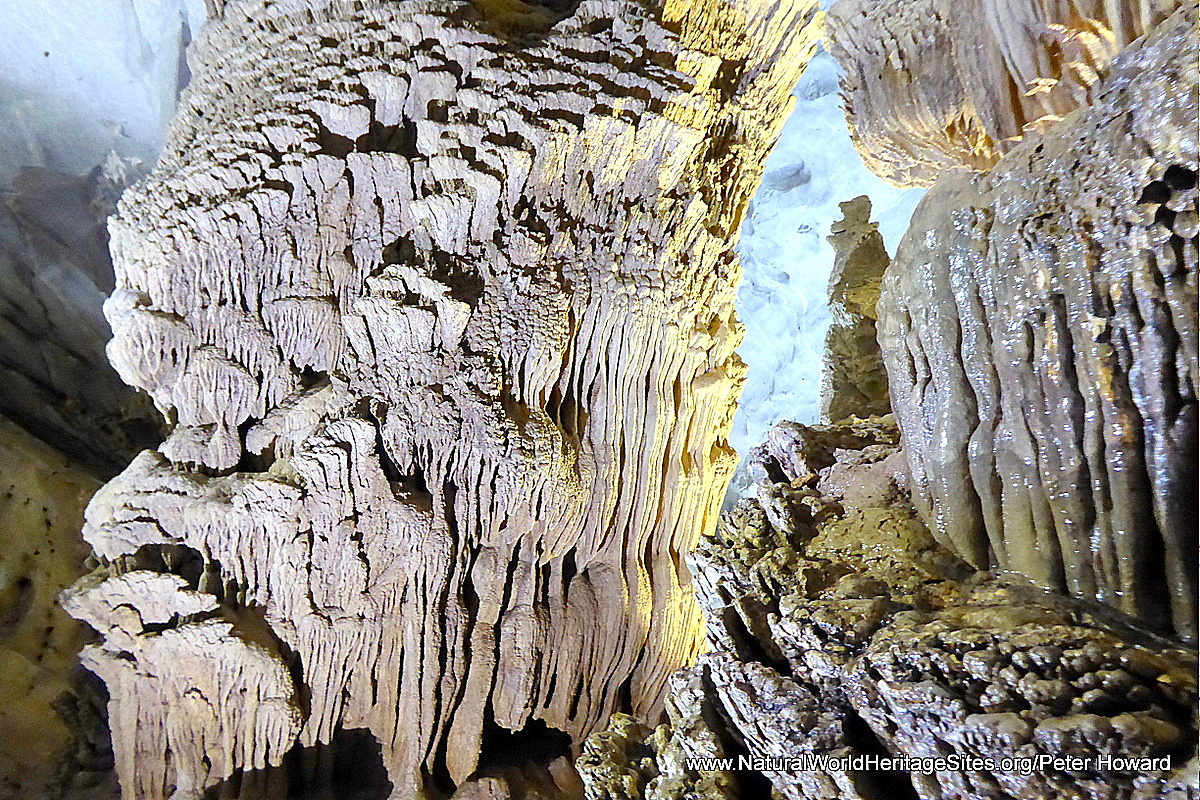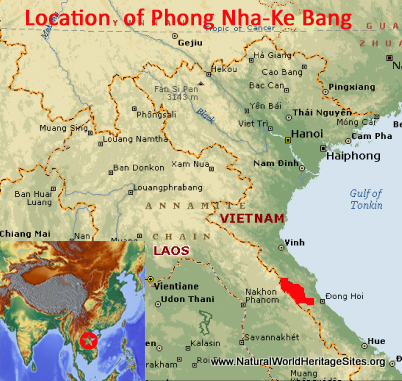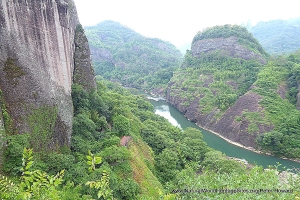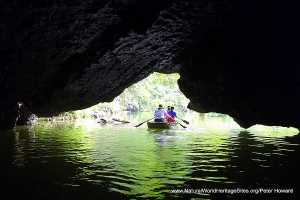EXPLORE VIETNAM’S PHONG NHA – KE BANG NATIONAL PARK with this slideshow, check the location map and get all the facts and information below.
For slideshow description see right or scroll down (mobile). Click to view slideshow
Location and Values: Phong Nha-Ke Bang National Park covers a substantial area of forested mountains along the border with Laos in central Vietnam. Its underlying geology is complex, and includes substantial areas of limestone where some of the world’s largest caves are found. There are some 300 known caves, including Son Doong (‘Mountain River Cave’) which is thought to be the world’s largest cave passage. Approximately 200 km of underground passages had been surveyed and mapped by early 2017 (including 57 new caves discovered in 2016 alone), and further exploration is likely to reveal many more. It is also an area of great biodiversity value, with over 2,700 vascular plant species and 800 vertebrates recorded. These include several large mammals only discovered for science in the 1990s, such as the critically endangered Saola. The fauna includes many species of endemic cave animals, such as blind white fish, and no fewer than four threatened primate taxa that are endemic to the small Annamite mountains region, namely the Hatinh langur, black Hatinh langur, red-shanked douc langur and white-cheeked gibbon.
Conservation Status and Prospects. According to IUCN’s Conservation Outlook Assessment (2014) the conservation status of this site is ‘good with some concerns’. The IUCN report notes that ‘while the very core of the site’s Outstanding Universal Value – the karst landscape and inherent examples of Earth’s history – is secure from degradation on a scale which would diminish this value, there is a trend for economic opportunity to overshadow the protection of the karst values represented by the caves. The existing show caves require remedial works to repair what damage can be repaired and more importantly they need infrastructure and policy development to minimize ongoing damage. The opening of additional caves in the buffer zone without adequate planning and development controls and proposals to open wild caves in the Strictly Protected Zone for tourism is particularly concerning. Furthermore, it is of concern that a clear benefit-sharing for local communities is not in place.’
Links:
Google Earth
Official UNESCO Site Details
IUCN Conservation Outlook
UNEP-WCMC Site Description
Birdlife IBA
Slideshow description
The slideshow is intended to ‘tell the story’ of the Phong Nha-Ke Bang National Park, through a portfolio of photos from a visit by Peter Howard in May 2017 and images of some of the larger and more remote caves by Ryan Debroodt of Oxalis Adventures. The slideshow begins with views of the forested mountains within the park approached from the north along the QL15 (Ho Chi Minh) road. Typical karst features are clearly visible in the landscape and cliffs. The next photos in the series show a visit to the Phong Nha Cave, the area’s primary visitor attraction. Tourism is developing rapidly at Phong Nha-Ke Bang with visitor numbers increasing from just 300,000 in 2010 to around 2.8 million visitors in 2016. Most of these people visit the Phong Nha cave, which involves a boat trip from a downstream jetty and into the first 1 km of cave passage (the only part of the caves’ 55km passageways that is open to the public). Some spectacular formations are illuminated and a short section of decorated passage can be visited on foot. The park’s most spectacular (and remote) caves, photographed by Ryan Debroodt, are shown in the following series of photos, featuring the massive passageways and unusual formations that occur in the Son Doong, Hang En and Hang Va caves. These are remote caves that can only be visited as part of an organized expedition (such as those offered by Oxalis Adventures). Most visitor activities are restricted to the area around Phong Nha cave and the village of Son Trach, with access from Highway 20. Some photos of attractions around this ‘tourist circuit’ are provided including the ‘semi-wild enclosure for wildlife rehabilitation’ (where hatinh and douc langurs are maintained), a ‘botanic garden’ (which includes some trails, a small museum, animal enclosures (macaques), and some waterfalls) and the park’s most spectacular and accessible cave, the Paradise Cave. This cave has large, long passages with stunning decorative formations and well-managed tourism facilities. Following the series of photos from Paradise Cave, the slideshow continues with two further ‘attractions’ that are likely to be of most interest to local visitors – the Mooc Spring Eco-trail (primarily a safe clear-river bathing facility) and Dark Cave (where kayak, zip-line and mud-bath ‘adventures’ are offered). The slideshow is completed with a series of photos from the DT562 road between Son Trach and the Laos border, the only road to pass through the interior of the site. The first part of this route passes through secondary forest (degraded by US bombing during the Vietnam war) and a popular memorial to a group of young martyrs who were buried alive in a cave when its entrance was bombed. About 10 km from Son Trach the degraded forest gives way to more pristine habitats where butterflies may be seen in great numbers and (towards the Laos border) one of the indigenous communities at Ban Arem village is being assisted towards a more sustainable future.
Factfile
Website Categories: Caves & Karst; Tropical & Sub-tropical Forests
Area: 123 km2
Inscribed: 2003 (extended 2015)
Criteria:
- Geological features (viii);
- Ecological processes (ix);
- Natural habitat for biodiversity (x);
- Significant number of rare, endemic and/or endangered species (x)





